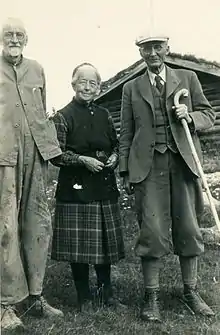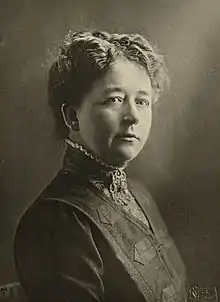Kristine Bonnevie
Kristine Elisabeth Heuch Bonnevie (8 October 1872 – 30 August 1948) was a Norwegian biologist and Norway's first female professor. Her fields of research were cytology, genetics and embryology.

Kristine Bonnevie | |
|---|---|
 | |
| Born | 8 October 1872 |
| Died | 30 August 1948 (aged 75) |
| Citizenship | Norway |
| Known for | First female professor in Norway First female member of the Norwegian Academy of Science and Letters Bonnevie-Ullrich Syndrome Studies on Papillary of Patterns Human Fingers |
| Awards | King's Medal of Merit in gold 1920 Order of St. Olav, 1st class "Fridtjof Nansen's reward", 1935 Norwegian Academy of Science and Letters, 1911 |
| Scientific career | |
| Fields | Cytology genetics embryology |
| Institutions | Royal Frederick University |
| Doctoral advisor | Arnold Lang Theodor Boveri Johan Hjort |
| Doctoral students | Thor Heyerdahl |
| Influences | Theodor Boveri Arnold Lang |
Personal life
She was the fifth of seven children to Jacob Aall Bonnevie (1838–1904) and Anne Johanne Daae (1839–1876). Jacob Aall Bonnevie had his eighth and ninth children with his second wife Susanne Bryn (1848–1927). Her family moved from Trondhjem to Kristiania in 1886.[1]
Bonnevie never married.[2] Her sister Honoria, the eldest child of Jacob and Anne, married Norwegian physicist and meteorologist Vilhelm Bjerknes.
Career
Bonnevie took her examen artium in 1892, began studying zoology in 1892, later switching to biology. She completed her doctoral dissertation, "Undersøgelser over kimcellerne hos Enteroxenos østergreni" (studies on the germ cells of Enteroxenos østergreni) in 1906. She also studied under Arnold Lang in Zürich from 1898 to 1899, under Theodor Boveri in Würzburg from 1900 to 1901, and under Edmund Beecher Wilson at Columbia University in New York from 1906 to 1907. She succeeded Johan Hjort as leader of the Zootomic laboratory in 1900. She was a professor at Royal Frederick University from 1912 to 1937, and founded the Institute of Inheritance Research in 1916.
In 1911, Bonnevie became the first female member of the Norwegian Academy of Science and Letters. Later, she founded the Norwegian Association for Female Academics, leading it from 1922 to 1925. She established a study home for young girls in 1916 and a students' house in 1923. Bonnevie was a member of the University's broadcasting committee from 1927 to 1937. Her students included Thordar Quelprud and Thor Heyerdahl.
Bonnevie was a central board member of the Liberal Left Party from 1909 to 1918.[3] She was elected as a member of Kristiania city council, serving from 1908 to 1919, and as a deputy representative to the Parliament of Norway in 1915. She served the term 1916–1918 as the deputy of Otto Bahr Halvorsen in the constituency Gamle Aker.[2][4]
Bonnevie received the King's Medal of Merit in gold in 1920, the Order of St. Olav, 1st class, in 1946, and "Fridtjof Nansen's reward" in 1935. The biology building on Blindern at the University of Oslo is named Kristine Bonnevie's House.[2]
Between 1922 and 1933, Bonnevie contributes to the works of the Committee on Intellectual Cooperation of the League of Nations (with Henri Bergson, Albert Einstein, Marie Curie etc.).[5]
See also
References
- "Jacob Aall Bonnevie". Erik Berntsen's genealogy sites. Retrieved 7 May 2017.
- Semb-Johansson, Arne. "Kristine Bonnevie". In Helle, Knut (ed.). Norsk biografisk leksikon (in Norwegian). Oslo: Kunnskapsforlaget. Retrieved 27 December 2011.
- Carstens, Svein (1987). Det Frisinnede Venstre 1909–1927 (in Norwegian). Trondheim: University of Trondheim.
- "Norges Offisielle Statistikk. VI. 65. Stortingsvalget 1915" (PDF) (in Norwegian). Statistics Norway.
- Grandjean, Martin (2018). Les réseaux de la coopération intellectuelle. La Société des Nations comme actrice des échanges scientifiques et culturels dans l'entre-deux-guerres [The Networks of Intellectual Cooperation. The League of Nations as an Actor of the Scientific and Cultural Exchanges in the Inter-War Period] (in French). Lausanne: Université de Lausanne.
Further reading
- "Kristine Elisabeth Heuch Bonnevie". Who Named it?. Retrieved 27 January 2017.
- Stamhuis, Ida H; Monsen, Arve (2007). "Kristine Bonnevie, Tine Tammes and Elisabeth Schiemann in early genetics: emerging chances for a university career for women". Journal of the History of Biology. 40 (3): 427–66. doi:10.1007/s10739-007-9132-x. PMID 18380054.